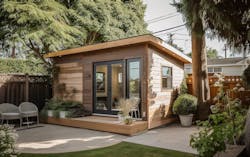Rising inflation, limited wage growth, and a competitive for-sale housing market have made it harder than ever for young Americans to find affordable single-family homes. Not only are existing home listings drying up, but land for new construction is also becoming increasingly difficult to find. Luckily, there's a housing type that offers a solution: the accessory dwelling unit (ADU).
ADUs allow Millennials and members of Generation Z, who are otherwise unable to buy a home, to live in their parents’ backyards or on another shared piece of land while still reaping the benefits of homeownership—just on a smaller scale. Still, the concept of ADU housing remains largely unknown across the U.S., Fortune reports.
A recent Freddie Mac consumer survey found that 71% of homeowners were unfamiliar with the concept, though 32% expressed interest in having one on their property once they learned about it.
Because ADUs are smaller, they also require fewer building materials to construct and less energy to heat; they can be passively cooled and need less electricity. Together, these result in reduced energy costs for the building. Additionally, prefabricated ADUs can be directly purchased, which further reduces construction time, can sidestep regulatory burdens such as site inspections, and lead to lower costs and waste.
